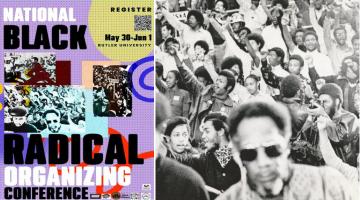“Coates assumes that all the leftists are white, and all race analysis is liberal.”
In 1940, Doxey Wilkerson, a Black Marxist educator, editor, and leader of the American Federation of Teachers, broke with Gunnar Myrdal and the Carnegie Corporation funded project, An America Dilemma: The Negro Problem and Modern Democracy. He did so because, though Myrdal claimed to be a socialist, he dishonestly excised structural analysis from his consideration of “the Negro question,” instead attributing racism to the hearts and values of Southern whites. Myrdal put forth this idealist interpretation of race relations to propound the liberal vision of his corporate funders, which required not only the omission of Wilkerson’s meticulously researched materialist analysis, but also the exclusion of the eminent scholar W.E.B. DuBois, whose 1935 tome, Black Reconstruction in America: An Essay Toward a History of the Part Which Black Folk Played in the Attempt to Reconstruct Democracy in America, 1860-1880, directly contradicted the Carnegie study’s disingenuous thesis.
Oliver Cromwell Cox offered a scathing critique of An American Dilemma, arguing that it brought “to finest expression practically all the vacuous theories of race relations which are acceptable among the liberal intelligentsia and which explain race relations away from the social and economic order.” Interestingly, Cox’s indictment of this evasion of social determinants in favor of a moralistic interpretation of American society applies almost perfectly to Ta-Nehisi Coates’ most recent attempt at analysis, “The First White President,” published in the October 2017 issue of The Atlantic. The article epitomizes the fundamental aporia of Coates’ brand of Black liberalism: that whiteness and racism constitute and stabilize U.S. politics even as they present an “existential danger to the country and the world.” In other words, whiteness and racism are totalizing structures, both thesis and antithesis. Much like Myrdal’s erroneous explication of racism as a set of individual attitudes, Coates disastrously employs “whiteness” as a type of metaphysics that is neither contextually specific nor historically situated, and that defies any grounding in social relations.
“Conjuring an unbroken lineage of ‘racism’ allows for the type of explanatory laziness and conceptual imprecision that evades engagements with the material conditions of Black folk.”
“The First White President”—simultaneously myopic and overreaching—is essentially predicated upon the tautology that whites elected Trump because of racism, and racists elected Trump because of whiteness. The use of tropological abstractions, as Asad Haider aptly notes, do little to mitigate Coates’ circular logic that renders both whiteness and racism analytically hollow. Two tropes in particular, “human plunder” (invoked ad nauseam in other of Coates’ works) and “bloody heirloom,” have the effect of mollifying and mystifying antiblackness rather than clarifying it. “Human plunder” dirempts forms of racialized exploitation and dispossession from their specific relations to the mode of production, instead construing them as some innate or abstruse white heritage rooted in the idea of not being a nigger. Perhaps even more egregious, “bloody heirloom” decontextualizes and de-historicizes processes of racialization that cannot be fully captured by platitudes such as, “racism remains, as it has since 1776, at the heart of this country’s political life.” Conjuring an unbroken lineage of “racism” allows for the type of explanatory laziness and conceptual imprecision that evades engagements with the material conditions of Black folk constituted by, at the very least, exorbitant unemployment and underemployment, dangerously low wages, spatial segregation, housing precariousness, and deepening impoverishment.
If we take Coates seriously, then we need not interrogate that the complex phenomena he simplistically calls “whiteness” are reproduced through specific technologies of racialized violence historically situated in regimes of capitalist expansion, including: the rollback of Reconstruction to stymie the sociopolitical development of freedmen; Jim Crow era lynchings meant to arrest the economic progress of Black folk but cloaked in specters of the Black rapist; the surveillance of Black political and literary activism during World War One because demands for civil rights were villified as “pro-Germanism”; race riots in 1919 and beyond meant to beat back the most minute assertions of Black self-determination; and the criminalization and punishment of Black (inter)nationalism, anticolonialism, and anti-imperialism as seditious and anti-American. In other words, the subjection of Blacks throughout U.S. history cannot be reduced to some identitarian notion of whiteness that culminates in the election of Donald Trump; rather, antiblackness is inextricable from the suppression of labor, the deportation of “alien” progressives, the incarceration of anti-capitalists, the indictment of communists and “fellow travellers,” the censure of demands for fundamental redistribution, and the overall repression of the left.
“The subjection of Blacks throughout U.S. history cannot be reduced to some identitarian notion of whiteness that culminates in the election of Donald Trump.”
Thus, Trump’s “birtherism” is not only the “modern recasting of the old American precept that black people are not fit to be citizens of the country they built;” it also inheres in the U.S. government’s aversion to foreigners and their purported linkage to radicalism and subversion that dates as far back as the Alien and Sedition Acts of 1798. Coates’ position that “a majority of Republican voters” considered Barack Obama’s presidency illegitimate—despite his decidedly American buildup of the surveillance state, warmongering, and denigration of poor Black folk—because they doubted that he was born in the United States diminishes the forces that were at play. The conjuncture of Obama’s purported foreignness and socialism, coupled with his Blackness, provided the basis for suspicion.
A relevant critique of the relationship between the American presidency, white supremacy, antiradicalism, and capitalist exploitation is possible. During the height of McCarranism and McCarthyism, Claudia Jones contended that Harry Truman and his anticommunist regime found her threatening because she was a “Negro woman” that “dared to challenge the civil rights lip-service cry of his reactionary administration which [was] yet to lift a finger to prosecute the lynchers, the Ku Klux Klan, or the anti-Semites.” She also argued that Cold War immigration laws, which restricted immigration from all Caribbean islands to a mere 100 persons per year, were not only racist, but were also antiradical, insofar as they aimed to drive out “progressive ideas.” Moreover, she linked U.S. governmentality to that of Hitler’s Germany, because both repressed labor, trampled upon democratic rights, murdered and jailed communists and other radicals, promoted war and militarization, and of course, oppressed Black and other racialized folk. For Jones, white supremacy was not a matter of attitude or morals, but rather of property rights, access to resources, and the hierarchical organization of American society. In fact, she rejected the idea that racism and discrimination were acts of individual choice, and stressed that they were forms of structural domination that needed to be eradicated if liberation for all people was to be achieved.
“For Jones, white supremacy was not a matter of attitude or morals, but rather of property rights, access to resources, and the hierarchical organization of American society.”
While virtually all of Jones’ critiques of the Truman administration are applicable to the current presidency—take for example the immigration ban, the suspension of DACA, threats to invade Venezuela and North Korea, the pardoning of Joe Arpaio, and the failure to condemn white terrorism in Charlottesville—Coates zeros in on what he perceives to be the moralistic failures of voters whose actions represented a commitment to white fantasy. This is not withstanding the social and political economic exigencies that have given rise to right populism not only in the United States, but also in parts of Latin America and Europe.
“The First White President” is not bereft of the occasional insight. Coates rightfully condemns the tendency of white liberals to downplay race. He also upbraids “the left” for their commitment to class over race, asserting that, “The left would much rather have a discussion about class struggles, which might entice the white working masses, instead of about the racist struggles that those same masses have historically been the agents and beneficiaries of.” However, the latter critique gives the impression that there is, in fact, no Black left. This elision of race radicals including Gerald Horne, Keeanga Yahmatta-Taylor, Glen Ford, Sundiata Cha-Jua and Barbara Ransby, assumes that all the leftists are white, and all race analysis is liberal. More problematically, it reifies the tendency of Black Cold War Liberalism to erase, denounce, or discredit Black radicals like Claudia Jones, Doxey Wilkerson, Ben Davis, Louise Thompson Patterson, James Jackson, Paul Robeson, Vicki Garvin, Queen Mother Audley Moore, who provided a viable alternative to mainstream demands for liberal rights and recognition.
People may argue that at least Ta-Nehisi Coates is opening up a conversation, which is better than saying nothing at all. To this I respond: no it’s not.
Charisse Burden-Stelly is an Assistant Professor and Mellon Faculty Fellow of Africana Studies and Political Science at Carleton College. She received a PhD in African Diaspora Studies at the University of California, Berkeley in 2016. Her areas of specialization include Black critical and political theory, epistemologies of Blackness, and the intersections of antiblackness and antiradicalism.



















